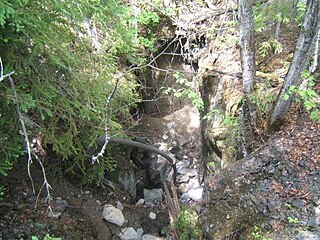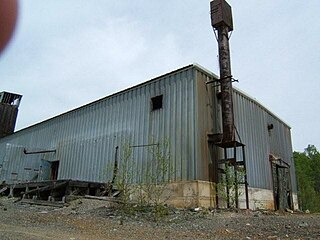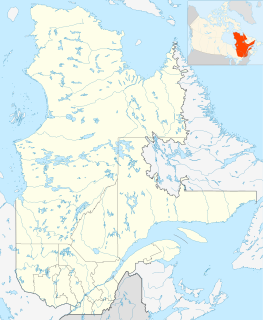 W
WAdams Mine is an abandoned open pit iron ore mine located in the Boston Township of the District of Timiskaming, 11 km (6.8 mi) south of Kirkland Lake in the Canadian provinceof Ontario. It is situated on the Canadian Shield.
 W
WThe Agnew Lake Mine is an historical uranium mine located approximately 10 kilometres (6.2 mi) northeast of Agnew Lake, Ontario and 75 kilometres (47 mi) east of Elliot Lake, Ontario.
 W
WBarton Mine, also known as Net Lake Mine, is an abandoned surface and underground mine in Northeastern Ontario, Canada. It is located about 0.50 km (0.31 mi) north of the Temagami Arena in Temagami North and just east of the Ontario Northland Railway in northwestern Strathy Township. Dating back to the early 1900s, it is one of the oldest mines in Temagami. Barton was the site of a fire in the early 1900s, after which it never had active mining again.
 W
WBeanland Mine, also known as Clenor Mine, is an abandoned surface and underground mine in Northeastern Ontario, Canada. It is located about 1 km (0.62 mi) west of Arsenic Lake and 4 km (2.5 mi) northwest of the town of Temagami in central Strathy Township. It is named after Sydney Beanland, who first claimed the mine site in the 1920s and was a director for the mine from 1937 to 1938.
 W
WThe Brunswick #6 mine is a copper-lead-zinc mine in the Bathurst Mining Camp of northern New Brunswick, Canada. It was discovered in October, 1952 and was in production from 1966 until 1983. The Brunswick #6 orebody was the first major sulfide deposit discovered in the Bathurst area. The mine operated as an open-pit operation until 1977 when a ramp was driven from the bottom of the pit to access deeper ore.
 W
WThe Cluff Lake mine, located about 700 km (430 mi) from Saskatoon, Saskatchewan at the northern terminus of Saskatchewan Highway 955, was owned and operated by AREVA Resources Canada, formerly COGEMA Resources. The project opened in 1980 and had both open pit and underground mines. It ceased uranium production at the end of 2002 when the ore reserves were depleted. It was originally scheduled to shut down in 2000, but additional higher ore grades in the underground mine allowed production to continue for an additional two years. Total production during the mine's 22-year operating life was over 62 million pounds of yellowcake.
 W
WThe Colomac Mine was a privately owned and operated open pit gold mine located 220 km northwest of Yellowknife in the Northwest Territories in Canada. The Colomac mine operated between 1990–1992, and 1994–1997. It was operated by Neptune Resources Limited that had little success in making a profit during its operation. In 1994, the mine had reopened under Royal Oak Mines Inc. Both Neptune Resources and Royal Oak Mines where both owned and operated by Peggy Witte. Due to low gold prices and high cost of mining, Royal Oak Mines was forced into bankruptcy. The Federal Government of Canada became owners of the mine, along with the related environmental issues. A major cleanup effort is under way to prevent the mine from polluting the environment, but this might be too late at this stage. This mine is now owned and controlled by the Indigenous and Northern Affairs department of the Federal government, while Public Works and Government services is the current contracting authority.
 W
WCopperfields Mine, originally known as Temagami Mine, is an abandoned copper and silver mine on Temagami Island in Lake Temagami, Ontario, Canada. The mine opened in 1955 and comprises both underground and surface workings within a sulfide ore body. Situated in Phyllis Township, the mine produced 34,000,000 dollars Canadian with 80 million pounds of copper, 230,028 ounces of silver and 13,271 ounces of gold. It was considered to be the largest deposit of nearly pure chalcopyrite ever discovered in Canada. A mill was not initially needed because the ore was 28% copper. The mine closed in 1972 and is now flooded by water. Ruins of the Copperfields mill are present as foundations. It is possible to find mineral specimens in the spoil heaps of the old mine, such as chalcopyrite, pyrite, bornite, malachite, dolomite, hessite, merenskyite, millerite, palladium, quartz and others. The Lake Temagami Access Road was created to ship ore from the mine site.
 W
WCoppersand Mine is an abandoned copper mine in Temagami, Northeastern Ontario, Canada. It is located near the eastern shore of Ferguson Bay of Lake Temagami. A winter road from Sandy Inlet through Coppersand Lake was created to the mine in 1957. Subsequently, a small road, known as Miner's Road, was constructed off Kokoko Sideroad in 1970 to access the mine. Mining from the late 1950s to 1970s resulted in the creation of a small open pit.
 W
WThe Danlou Occurrence, also known as the Danlou Gold Occurrence and the Mortimer Occurrence, is a mineralized zone in Northeastern Ontario, Canada. Gold is the occurrence's primary commodity while copper and silver are secondary commodities. It occurs in a quartz vein within a diabase-porphyry shear zone. Pyrite and chalcopyrite are present in small amounts.
 W
WThe Diavik Diamond Mine is a diamond mine in the North Slave Region of the Northwest Territories, Canada, about 300 km (190 mi) northeast of Yellowknife.
 W
WDome Mine is situated in the City of Timmins, Ontario, Canada; and was developed during the Porcupine Gold Rush.
 W
WThe Ekati Diamond Mine ("Ekati") is Canada's first surface and underground diamond mine. It is located 310 km (190 mi) north-east of Yellowknife, Northwest Territories, and about 200 km (120 mi) south of the Arctic Circle, near Lac de Gras. Until 2014 Ekati was a joint venture between Dominion Diamond Mines (80%), and the two geologists who discovered kimberlite pipes north of Lac de Gras, Chuck Fipke and Stewart Blusson each holding a 10% stake in the mine, until Fipke sold his share to Dominion.
 W
WFaro is a town in the central Yukon, Canada, formerly the home of the Faro Mine, the largest open pit lead–zinc mine in the world as well as a significant producer of silver and other natural resource ventures. The mine was built by the Ralph M. Parsons Construction Company of the USA with General Enterprises Ltd. of Whitehorse being the main subcontractor. As of 2011, the population is 344, considerably lower than its peak of over 2,100 in February 1982. Faro was named after the card game. credited with discovering several significant deposits of lead and zinc ore and playing a major role in the discovery of the Faro Mine, which became Canada's largest lead-zinc mine.
 W
WThe Gunnar Mine was a uranium mine in northern Saskatchewan, Canada located around 25 kilometres (16 mi) southwest of the community of Uranium City. The mine was situated on the Crackingstone Peninsula on the north shore of Lake Athabasca in the Beaverlodge Uranium District.
 W
WHeath Steele Mines, situated 60 km northwest of Newcastle, New Brunswick, Canada, at the headwaters of the Tomogonops and Little Rivers, was a large and productive copper, lead and zinc mine which operated from 1956 to 1999. The mine was an economic cornerstone of Miramichi communities throughout this period.
 W
WThe Highland Valley Copper mine is the largest open pit copper mine in Canada, located near Logan Lake, British Columbia. It is an amalgamation of three historic mining operations: Bethlehem, Lornex and Highmont.
 W
WThe Kanichee Mine, also less commonly known as the Ajax Mine, is an abandoned base metal and precious metal mine, located in the Temagami region of northeastern Ontario, Canada. It is near the small unincorporated community of Temagami North, accessed by the Kanichee Mine Road from Highway 11. The Kanichee Mine zone has been explored and mined discontinuously from as early as 1910. During the 20th century, it operated and closed down at least three times, with the most recent being from 1973 to 1976. To date, the discontinuous operation of Kanichee Mine has produced 4.2 million pounds of metal.
 W
WThe Kemess Mine was an open-pit copper and gold mine, located just northeast of the foot of Thutade Lake, at the head of the Finlay River, in the Omineca Mountains of the Northern Interior of British Columbia, Canada. It was operated by Royal Oak Mines from 1998 to 1999, when it was bought by Northgate Minerals. Northgate operated the mine until its closure in 2011; that year Northgate was taken over by AuRico Gold. In 2014 AuRico Gold partitioned off its portion of Kemess Mine ownership creating a new company called AuRico Metals.
 W
WThe Key Lake mine is a former uranium mine in Saskatchewan, Canada. It is 570 kilometres (350 mi) north of Saskatoon by air on the southern rim of the uranium-rich Athabasca Basin. Key Lake was initially developed to open-pit mine two nearby uranium ore deposits: the Gaertner deposit and the Deilmann deposit. Mining of this ore ceased in the late 1990s; the Key Lake mill now processes uranium ore from the McArthur River mine and from existing stockpiles on site. High-grade ore from McArthur river is blended with lower grade local rock before being passed through the mill. The mill has a permitted annual production capacity of 25 million pounds of U3O8. In addition, ammonium sulfate fertilizer is produced as a byproduct from used reagents. The pits of the mined out local deposits are being used as mill tailings management facilities.
 W
WThe McClean Lake mine is a uranium mine and milling operation located west of Wollaston Lake, about 700 kilometres north of Saskatoon, in the Athabasca Basin region of Saskatchewan, Canada. The McClean ore body was discovered in 1979, followed by the discovery of the JEB ore body in 1982. From 1985 to 1990, a cluster of deposits named Sue A, Sue B and Sue C were discovered.
 W
WThe Meadowbank Gold Mine is an open pit gold mine operated by Agnico-Eagle Mines in the Kivalliq district of Nunavut, Canada.
 W
WMoose River Gold Mines is a Canadian rural community located in Nova Scotia's Halifax Regional Municipality. It is located at the junction of Moose River Road and Mooseland Road. No numbered highways run through Moose River Gold Mines. Gold was discovered in the area in 1866 and mining started in the 1870s. Interest waned around 1900 but rose in the 1930s. The community gained international attention in 1936 when three men were trapped in the mine.
 W
WThe Murray Brook Mine is a VMS deposit in the Bathurst Mining Camp (BMC) of northern New Brunswick, Canada owned by NovaGold Resources. The deposit was discovered in 1955 and contains the largest gossan zone in the BMC. From 1989 to 1992 the gossan zone was processed for gold and silver. In 1992 copper rich ore was crushed and tested for heap leaching.
 W
WNorrie Mine is an abandoned surface mine in Northeastern Ontario, Canada. It is located about 1 km (0.62 mi) northeast of Temagami North on the eastern shore of Net Lake in eastern Strathy Township. It is named after L. B. Norrie of New York, who first claimed the mine site.
 W
WO'Connor Mine, also known as Milestone Mine, is an abandoned surface mine in Northeastern Ontario, Canada. It is located about 1 km (0.62 mi) southwest of the town of Temagami near the Northeast Arm of Lake Temagami in northern Strathcona Township. It is named after John O'Connor who first developed the mine site.
 W
WPhoenix Mine was an open pit and underground mining operation in city of Phoenix in the Boundary Country region of British Columbia, Canada that operated in the early and mid 20th century, run by the Granby Consolidated Mining, Smelting and Power Company. It was discovered in 1891, but was a lower grade copper deposit than the Rossland and Slocan deposits. The low grade and the nearest railroad being 75 miles (121 km) resulted in the Phoenix receiving less attention.
 W
WPremier was a large gold mining camp in British Columbia, Canada some 18 miles from Stewart. It ran from the years 1918 to 1953 and was a large employer in the area. Huge bunkhouses, generators, concentrators, machine and cook houses sat on the hillside. A road provided access to the area, snowfall pending. Horses and cat tractors were used.
 W
WPriest Mine is an abandoned surface and underground mine in Northeastern Ontario, Canada. It is located about 19 km (12 mi) northwest of the hamlet of Marten River on an island in north-central Cross Lake. Dating back to the early 1900s, it is one of the oldest mines in the municipality of Temagami.
 W
WQueenston is a compact rural community and unincorporated place 5 kilometres (3.1 mi) north of Niagara Falls in the Town of Niagara-on-the-Lake, Ontario, Canada. It is bordered by Highway 405 to the south and the Niagara River to the east; its location at the eponymous Queenston Heights on the Niagara Escarpment led to the establishment of the Queenston Quarry in the area. Across the river and the Canada–US border is the village of Lewiston, New York. The Lewiston-Queenston Bridge links the two communities. This village is at the point where the Niagara River began eroding the Niagara Escarpment. During the ensuing 12,000 years the Falls cut an 11 kilometres (6.8 mi) long gorge in the Escarpment southward to its present-day position.
 W
WRabbit Lake is the second largest uranium milling facility in the western world, and is the longest operating uranium production facility in Saskatchewan. The facility is located approximately 800 km north of Saskatoon, Saskatchewan, on the northeast edge of the uranium rich Athabasca Basin. The closest community is Wollaston Lake, about 40 kilometers by lake or air. Rabbit Lake was the first Canadian mine to offer a seven-days-in/seven-days-out commuter system of staffing. Access is provided by Highway 905. Production at Rabbit Lake was suspended in April 2016.
 W
WRaglan Mine is a large nickel mining complex in the Nunavik region of northern Quebec, Canada. It is located approximately 100 kilometres (62 mi) south of Deception Bay. Discovery of the deposits is credited to Murray Edmund Watts in 1931 or 1932. It is owned and operated by Glencore Canada Corporation. The mine site is located in sub-arctic permafrost of the Cape Smith Belt, with an average underground temperature of −15 °C (5 °F).
 W
WSherman Mine is a closed open pit mine in Temagami, Ontario, Canada. It was a major producer of iron ore, starting production in 1968 and closing in 1990. Sherman was the largest open pit mine in Temagami, consisting of seven open pits known as the East Pit, South Pit, North Pit, West Pit and the Turtle Pits. The mine was discovered in the early part of the twentieth century, however interest was limited as a result of silver and gold discoveries in northeastern Ontario. While the Ontario government offered bounties to producers of iron ore, there was little interest in putting any iron mine into production as a result of cheaper Mesabi Range ores from the US and the Great Depression. It was only in the 1950s that Canadian steel producers started to investigate domestic supplies of iron ore. This would lead to the re-opening of the Moose Mountain Mine and development of the Adams, Sherman and Bruce Lake mines in Northern Ontario. The Sherman Mine operated in tandem with the Adams Mine in Kirkland Lake, and when the Adams Mine approached exhaustion of its economic ore reserves, the decision was made to also close the Sherman Mine. The surface infrastructure was removed and the site was abandoned. The waste piles are currently used by the municipality as a source of crushed stone for road works.
 W
WThe Stellarton Surface Coal Mine is an open pit reclamation coal mine located in Stellarton, Nova Scotia. It is owned and operated by Pioneer Coal Limited.
 W
WThe Temagami Occurrence is a geological occurrence in Northeastern Ontario, Canada. It is located near the southern end of Kanichee Lake in west-central Strathy Township. It is named after Temagami, the municipality in which the occurrence is located in.
 W
WThe Victor Mine is the first Canadian diamond mine located in Ontario, and De Beers' second diamond mine in Canada. It is located in the Northern Ontario Ring of Fire, in the James Bay Lowlands 90 kilometres (56 mi) west of Attawapiskat in the remote northern part of the province. In June 2005, the Attawapiskat First Nation voted in favour (85.5%) of ratifying the Impact Benefit Agreement (IBA). Construction of the mine began in February 2006 which created 3200 positions; mining and operations will create around 400 permanent positions. The Victor Mine is an open-pit mine, with a processing plant, workshops, and an airstrip located on site. By 2013–2014 royalties collected from De Beers Victor Mine amounted to $226. At that time De Beers was continuing to pay off its "$1 billion investment to build the mine and from now until it closes, the company expects to pay tens of millions of dollars in royalties."